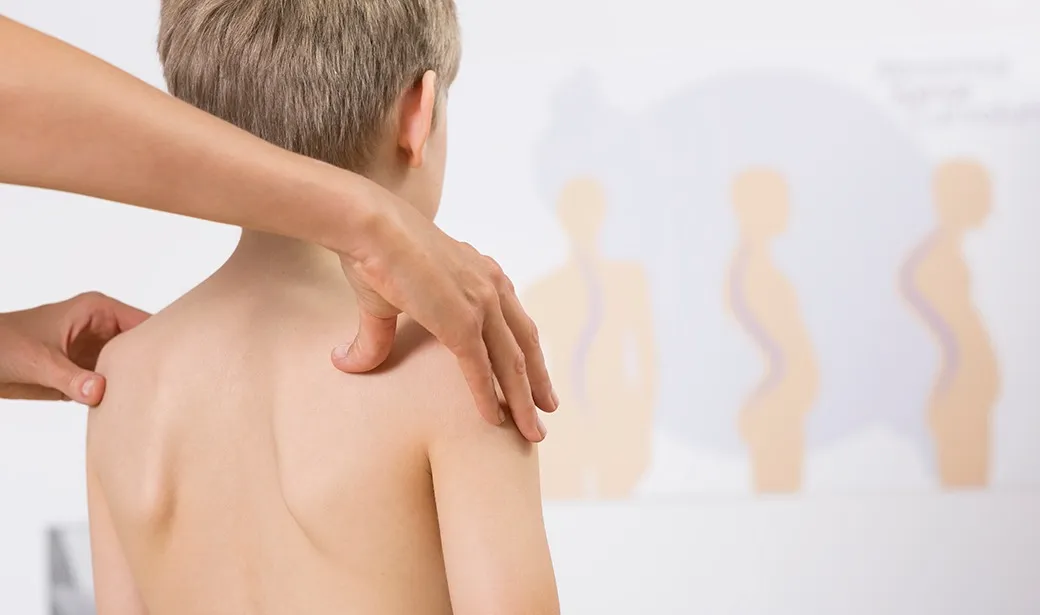The spine is a flexible structure that has a number of forward and backward curves that support how it works and enable it to adapt. However it is not uncommon to see side to side curves in the spine. When someone has such a ‘lateral curve’ it is called a scoliosis and may be ‘C’ or ’S’ shaped. Many such curves are just a reflection of how we have developed and have little impact on us. Some people may notice one shoulder higher than the other or their hips may look uneven.
Types of scoliosis
However, there are other types of scoliosis that may develop at different times in life, and these can have a more significant impact. Some can be due to existing conditions that affect the strength of the spinal muscles, like cerebral palsy or developmental conditions that often present with more complex symptoms affecting general health. However, there is a type of scoliosis that can develop during childhood and is related to how the spine grows. This is known as idiopathic (or unexplained) scoliosis and is more commonly seen in up to 5% of the population of juvenile or adolescent girls (boys can be affected too but far less commonly than girls). Although such scolioses do not commonly cause other health problems, back and neck pain, limitations with physical activity and cosmetic issues can have a significant affect on a young persons life so the sooner they are identified the better.
Idiopathic scolioses are genetic, so if a member of your family had a significant curvature it is possible that girls in this family may develop such a curve themselves. Typically this can present from about 10 years of age. It is not always easy to see but initially a child developing such a curve may complain of back or shoulder pain fairly routinely, particularly if they are sitting at school or standing for long periods. As a parent you might notice things like a difference in shoulder height, position of the shoulder blades, whether ribs are higher on one side and/or a trunk shift where the body is shifted to one side or a tendency to hold the head to one side. You may also begin to see the C or S curve when you look at their spines. This photograph shows some of these features, most notably a curve in the mid to low back, protruding scapula on the right and a difference in shoulder and hip heights.
Case study 1
A parent who had been attending our clinic for treatment of low back pain bought their 13 year old daughter in to see one of our osteopaths because she had been complaining of shoulder and back pain. They had also noticed that she tended to ‘slouch to one side’ and wondered if she had a posture problem. Examination quickly identified that the young girl had what appeared to be an idiopathic scoliosis, and she was referred back to her GP with a detailed report citing the clinical findings. Her GP subsequently referred her on to a specialist who, following x-ray examination confirmed the diagnosis.
If you notice such symptoms or signs it is important to consult with a medical expert such as your osteopath or doctor promptly so that they can assess your child’s spine. Recognising such curves early is important because the sooner they are recognised the sooner they can be treated. Exercise and osteopathy/physiotherapy can be helpful in maintaining flexibility and reducing the curvature by stretching and strengthening the spinal tissues. However, in some cases there may be the need to undergo medical treatment such as bracing or surgery to reduce these curves and prevent them from becoming too significant. GP’s can refer to a specialist who will be able to assess using x-rays and other clinical tools to best identify how to help your child. In many cases no medical intervention is needed but in some there may be a need for bracing or surgery if the curve continues to worsen. The good news is that in the majority of cases treatment is effective in managing symptoms.
Case study 2
Another teenager came to our clinic complaining of low back and shoulder pain, particularly with sitting. She also had cerebral palsy which had left her with weakness through her left side, affecting her spinal muscles as well as those of her arm and leg. It was identified that, as a consequence of this muscle imbalance, she had developed a scoliosis, which her consultant felt was significant enough for her to be put forward for spinal fusion surgery.
We started a course of treatment which involved osteopathy, massage therapy and exercise to stretch and strengthen her back and to counteract the affects of the curvature. Over a 4 month period her back pain reduced significantly and when she returned to the consultant he found that her curves had reduced to the extent that she no longer needed surgery.
Other resources
If you have any concerns or questions about your child’s back or if you think they might have a scoliosis give us a ring. We would be happy to evaluate your child and help you decide how best to help them. There are also plenty of helpful online resources that you may find helpful.
The Scoliosis Association (https://www.sauk.org.uk) provides lots of excellent information and support for parents and children living with scoliosis.
There are also excellent resources for children and adolescents, such as Curvy Girls (https://www.curvygirlsscoliosis.com).






